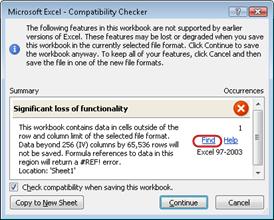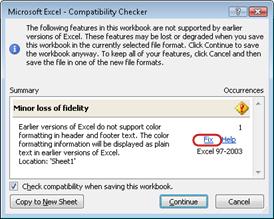Worksheet compatibility issues
Important:
-
Before you save an Excel 2007 or newer version workbook to an earlier file format, you should address issues that cause a significant loss of functionality so that you can prevent permanent loss of data or incorrect functionality. Excel's Compatibility Checker can help you identify potential issues.
-
Issues that cause a minor loss of fidelity might or might not have to be resolved before you continue saving the workbook — data or functionality is not lost, but the workbook might not look or work exactly the same way when you open it in an earlier version of Microsoft Excel.
The Compatibility Checker will automatically launch when you attempt to save a workbook in the Excel 97-2003 .xls format. If you're not concerned about potential issues, you can turn the Compatibility Checker off.

For more information about the Compatibility Checker, see Save an Excel workbook for compatibility with earlier versions of Excel.
In this article
Issues that cause a significant loss of functionality
| Issue | Solution |
| This workbook contains data in cells outside of the row and column limit of the selected file format. Data beyond 65,536 rows by 256 columns will not be saved. Formula references to data in this region will return a #REF! error. | What it means Beginning with Excel 2007, worksheet size is 1,048,576 rows tall by 16,384 columns wide, but Excel 97-2003 is only 65,536 rows by 256 columns. Data in cells outside of this row and column limit is lost in Excel 97-2003. What to do In the Compatibility Checker, click Find to locate the cells and ranges that fall outside the row and column limits, select those rows and columns, and then place them inside the column and row limits of the worksheet, or on another worksheet by using Cut and Paste. |
| This workbook contains Scenarios with references to cells outside of the row and column limits of the selected file format. These Scenarios will not be saved in the selected file format. | What it means A scenario in the worksheet refers to a cell outside Excel 97-2003's row and column limit (65,536 rows by 256 columns), and is no longer available when you continue saving the workbook to the earlier Excel version. What to do In the Scenario Manager, look for the scenario that contains a reference that falls outside the row and column limit of the earlier Excel version, and then change the reference to a location within that limit. On the Data tab, in the Data Tools group, click What If Analysis > Scenario Manager. In the Scenarios box, locate the scenario that causes the compatibility issue, and then edit its reference. |
| This workbook contains dates in a calendar format that is not supported by the selected file format. These dates will be displayed as Gregorian dates. | What it means Beginning with Excel 2007, you can create custom international calendar formats, such as Hebrew Lunar, Japanese Lunar, Chinese Lunar, Saka, Zodiac Chinese, Zodiac Korean, Rokuyou Lunar, and Korean Lunar. However, these calendar formats are not supported in Excel 97-2003. What to do To avoid loss of functionality, you should change the calendar format to a language (or locale) that is supported in Excel 97-2003. |
| This workbook contains dates in a calendar format that is not supported by the selected file format. These dates must be edited by using the Gregorian calendar. | What it means Beginning with Excel 2007, you can apply a non-Western calendar type, such as Thai Buddhist or Arabic Hijri. In Excel 97-2003, these calendar types can only be edited in Gregorian. What to do To avoid loss of functionality, you should change the calendar format to a language (or locale) that is supported in Excel 97-2003. |
| This workbook contains more cells with data than are supported in earlier versions of Excel. Earlier versions of Excel will not be able to open this workbook. | What it means Beginning with Excel 2007, the total number of available cell blocks (CLBs) is limited by available memory. In Excel 97-2003, the total number of available CLBs is limited to 64,000 CLBs in an instance of Excel. A CLB includes 16 worksheet rows. If all rows in a worksheet contain data, you would have 4,096 CLBs in that worksheet, and you could have only 16 such worksheets in a single instance of Excel (regardless of how many workbooks you have open in Excel). What to do To make sure that the workbook does not exceed the 64,000 CLB limit and that it can be opened in Excel 97-2003, you should work in Compatibility Mode in Excel 2007 and up after you save the workbook to Excel 97-2003 file format. In Compatibility Mode, Excel keeps track of the CLBs in the active workbook. |
| One or more cells in this workbook contain a sparkline. Sparklines will not be saved. | What it means In Excel 97-2010, sparklines are not displayed on the worksheet. However, all sparklines remain available in the workbook and are applied when the workbook is opened again in Excel 2010 and up. What to do In the Compatibility Checker, click Find to locate cells that contain sparklines, and then make the necessary changes. For example, you could apply conditional formatting instead of or in addition to the sparklines that won't be displayed in the earlier version of Excel. |
| This file originally contained features which were not recognized by this version of Excel. These features will not be saved. | What it means Features that were used in this workbook are not available in versions of Excel prior to Excel 2007 (Excel 97-2003), and they will be lost. What to do If you know which features might be causing this issue, remove or replace them if possible, and then save the file in the file format that you want. |
| This file originally contained features which were not recognized by this version of Excel. These features are not preserved when saving an OpenXML file to the XLSB file format, or vice versa. | What it means Features that were used in this workbook will not be available in Excel 2007 when you save an OpenXML file to an Excel Binary Workbook (.xlsb), or vice versa. When you continue saving the file, the features will be lost. What to do If you know which features might be causing this issue, remove or replace them if possible, and then save the file in the file format that you want. |
Issues that cause a minor loss of fidelity
| Issue | Solution |
| Earlier versions of Excel do not support color formatting in header and footer text. The color formatting information will be displayed as plain text in earlier versions of Excel. | What it means Beginning with Excel 2007, you can apply color formatting to header and footer text. You cannot use color formatting in headers and footers in Excel 97-2003. What to do In the Compatibility Checker, click Fix if you want to remove the color formatting. |
| This workbook contains worksheets that have even page or first page headers and footers. These page headers and footers cannot be displayed in earlier versions of Excel. | What it means Beginning with Excel 2007, you have the option to display different header and footer text on even pages or on the first page. In Excel 97-2003, even page or first page headers and footers cannot be displayed, but they remain available for display when you open the workbook in Excel 2007 and up again. What to do If you frequently save a workbook to Excel 97-2003 file format, it is best not to specify even or first page headers or footers for that workbook. |
| Some cells or styles in this workbook contain formatting that is not supported by the selected file format. These formats will be converted to the closest format available. | What it means Beginning with Excel 2007, different cell formatting or cell style options, such as special effects and shadows, are available. These options are not available in Excel 97-2003. What to do When you continue saving the workbook, Excel applies the closest available format, which can be identical to another format you applied to something else. To avoid duplication of formats, you can change or remove the cell formatting and cell styles that are not supported before you save the workbook to Excel 97-2003 file format. |
| This workbook contains more unique cell formats than are supported by the selected file format. Some cell formats will not be saved. | What it means Beginning with Excel 2007, you can use 64,000 unique cell formats, but in Excel 97-2003, you can only use up to 4,000 unique cell formats. Unique cell formats include any specific combination of formatting that is applied in a workbook. What to do To avoid losing specific cell formats that you want to keep available in Excel 97-2003, you can remove some cell formats that are not as important to keep. |
| This workbook contains more unique font formats than are supported in the selected file format. Some font formats will not be saved. | What it means Beginning with Excel 2007, 1,024 global font types are available, and you can use up to 512 of them per workbook. Excel 97-2003 supports less unique font formats. What to do To avoid losing specific font formats that you want to keep available in Excel 97-2003, you can remove some font formats that are not as important to keep. |
Need more help?
You can always ask an expert in the Excel Tech Community, get support in the Answers community, or suggest a new feature or improvement on Excel User Voice.


No comments:
Post a Comment